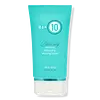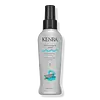What's inside
What's inside
 Benefits
Benefits

 Concerns
Concerns

 Ingredients Side-by-side
Ingredients Side-by-side

Water
Skin ConditioningPropylene Glycol
HumectantCyclopentasiloxane
EmollientDimethicone
EmollientHelianthus Annuus Seed Extract
Skin ConditioningGinkgo Biloba Leaf Extract
Skin ConditioningHydrolyzed Vegetable Protein Pg-Propyl Silanetriol
Skin ConditioningHydrolyzed Keratin
HumectantEthylhexyl Methoxycinnamate
UV AbsorberAcrylates/C10-30 Alkyl Acrylate Crosspolymer
Emulsion StabilisingSodium Lauroamphoacetate
CleansingIsostearic Acid
CleansingPEG-60
HumectantHydrogenated Castor Oil
EmollientHydrolyzed Soy Protein
HumectantAmodimethicone
Iodopropynyl Butylcarbamate
PreservativeC11-15 Pareth-7
EmulsifyingLaureth-9
EmulsifyingGlycerin
HumectantTrideceth-12
EmulsifyingShorea Stenoptera Seed Butter
EmollientSodium Hydroxide
BufferingButylene Glycol
HumectantDMDM Hydantoin
PreservativeDisodium EDTA
Parfum
MaskingWater, Propylene Glycol, Cyclopentasiloxane, Dimethicone, Helianthus Annuus Seed Extract, Ginkgo Biloba Leaf Extract, Hydrolyzed Vegetable Protein Pg-Propyl Silanetriol, Hydrolyzed Keratin, Ethylhexyl Methoxycinnamate, Acrylates/C10-30 Alkyl Acrylate Crosspolymer, Sodium Lauroamphoacetate, Isostearic Acid, PEG-60, Hydrogenated Castor Oil, Hydrolyzed Soy Protein, Amodimethicone, Iodopropynyl Butylcarbamate, C11-15 Pareth-7, Laureth-9, Glycerin, Trideceth-12, Shorea Stenoptera Seed Butter, Sodium Hydroxide, Butylene Glycol, DMDM Hydantoin, Disodium EDTA, Parfum
Water
Skin ConditioningPvp
Emulsion StabilisingGlycerin
HumectantPropylene Glycol
HumectantPolysorbate 20
EmulsifyingPhenoxyethanol
PreservativeParfum
MaskingAmodimethicone
Ethylhexylglycerin
Skin ConditioningSaccharum Officinarum Extract
MoisturisingTrideceth-12
EmulsifyingLaureth-9
EmulsifyingC11-15 Pareth-7
EmulsifyingBenzyl Salicylate
PerfumingCitronellol
PerfumingHydroxycitronellal
PerfumingButylphenyl Methylpropional
PerfumingLimonene
PerfumingIngredients Explained
These ingredients are found in both products.
Ingredients higher up in an ingredient list are typically present in a larger amount.
This water-soluble silicone is used for its hydrating and softening properties. It is used to add a silky feel to skincare products and has great benefits for haircare.
In haircare, this ingredient:
- Adds shine
- Protects color
- Offers thermal protection
- Boosts hair strength
- Does not build up as easily
Another name for this ingredient is C11-15 Alketh-7. It has emulsifying and surfactant properties, meaning it helps keep ingredients together in a formula.
Glycerin is already naturally found in your skin. It helps moisturize and protect your skin.
A study from 2016 found glycerin to be more effective as a humectant than AHAs and hyaluronic acid.
As a humectant, it helps the skin stay hydrated by pulling moisture to your skin. The low molecular weight of glycerin allows it to pull moisture into the deeper layers of your skin.
Hydrated skin improves your skin barrier; Your skin barrier helps protect against irritants and bacteria.
Glycerin has also been found to have antimicrobial and antiviral properties. Due to these properties, glycerin is often used in wound and burn treatments.
In cosmetics, glycerin is usually derived from plants such as soybean or palm. However, it can also be sourced from animals, such as tallow or animal fat.
This ingredient is organic, colorless, odorless, and non-toxic.
Glycerin is the name for this ingredient in American English. British English uses Glycerol/Glycerine.
Learn more about GlycerinThis ingredient comes from lauryl alcohol. It is an emulsifying surfactant and helps mix sold and liquid components.
Other names for this ingredient include Macrogol lauryl ether and Polidocanol.
Parfum is a catch-all term for an ingredient or more that is used to give a scent to products.
Also called "fragrance", this ingredient can be a blend of hundreds of chemicals or plant oils. This means every product with "fragrance" or "parfum" in the ingredients list is a different mixture.
For instance, Habanolide is a proprietary trade name for a specific aroma chemical. When used as a fragrance ingredient in cosmetics, most aroma chemicals fall under the broad labeling category of “FRAGRANCE” or “PARFUM” according to EU and US regulations.
The term 'parfum' or 'fragrance' is not regulated in many countries. In many cases, it is up to the brand to define this term.
For instance, many brands choose to label themselves as "fragrance-free" because they are not using synthetic fragrances. However, their products may still contain ingredients such as essential oils that are considered a fragrance by INCI standards.
One example is Calendula flower extract. Calendula is an essential oil that still imparts a scent or 'fragrance'.
Depending on the blend, the ingredients in the mixture can cause allergies and sensitivities on the skin. Some ingredients that are known EU allergens include linalool and citronellol.
Parfum can also be used to mask or cover an unpleasant scent.
The bottom line is: not all fragrances/parfum/ingredients are created equally. If you are worried about fragrances, we recommend taking a closer look at an ingredient. And of course, we always recommend speaking with a professional.
Learn more about ParfumPropylene Glycol is an odorless, colorless liquid. As a humectant, it helps skin retain moisture. It also aids in delivering active ingredients.
Another role of this ingredient is preventing a product from melting or freezing. Propylene glycol also adds antimicrobrial properties to a product, elongating product lifespan.
This ingredient is considered an organic alcohol and commonly added into both cosmetics and foods.
Those with sensitive skin or conditions may develop a rash when using this ingredient.
Learn more about Propylene GlycolWe don't have a description for Trideceth-12 yet.
Water. It's the most common cosmetic ingredient of all. You'll usually see it at the top of ingredient lists, meaning that it makes up the largest part of the product.
So why is it so popular? Water most often acts as a solvent - this means that it helps dissolve other ingredients into the formulation.
You'll also recognize water as that liquid we all need to stay alive. If you see this, drink a glass of water. Stay hydrated!
Learn more about Water